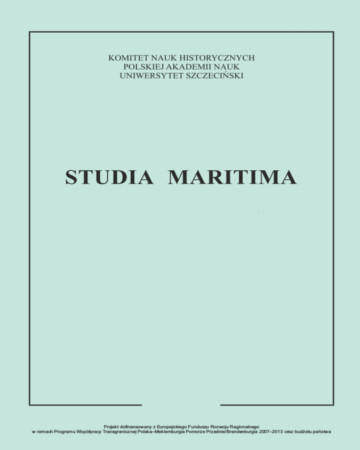






| Authors: |
Gabriela
Majewska

Uniwersytet Gdański, Instytut Historii |
| Keywords: | Poland Sweden the Great Northern War Magnus Stenbock |
| Data publikacji całości: | 2018 |
| Page range: | 20 (135-154) |
| 1. | Central Archives of Historical Records (Archiwum Główne Akt Dawnych), Archiwum Radziwiłłów, Jnl. II, no. 1970, file 14, Appeal of the General Commissioner (Odezwa Generalnego Komisarza) Gen. Stenbock 23.10.1702. |
| 2. | Berättelse om General-Krigskommissariatets viktigaste åtgöranden 1702–1704, Karolinska Krigares Dagböcker, vol. XII, Lund 1918. |
| 3. | Bref och skrifvelser till Carl XII från Magnus Stenbock 1702–1705, Karolinska Krigares Dagböcker, vol. XII, Lund 1918. |
| 4. | Biblioteka Czartoryskich, ms 196, 525, 1995, |
| 5. | Journal över expeditionen 1702–1703 af generalmajoren, grefve Magnus Stenbock, Karolinska Krigares Dagböcker, vol. XII, Lund 1918. |
| 6. | M. Stenbock, Kårt Deduction af den Expedition mig uppdragen wart…, Marienburg d:26 Martii 1704, Karolinska Krigares Dagböcker, vol. XII, Lund 1918. |
| 7. | Magnus Stenbock och Eva Oxenstierna en brefväxling, utg. av Carl Magnus Stenbock, del I, Stockholm 1913. |
| 8. | “Nils Reuterholms Journal”, Historiska Handlingar 36 (1957), 2. |
| 9. | Anusik Z. Karol XII. Wrocław, 2006. |
| 10. | Asker B. “Officerarna och det svenska samhället 1650–1700”, Studie Historica Uppsaliensie 133 (1983). |
| 11. | Cavallie J. “De höga officerarna. Studier i den svenska militäre hierarkien under 1600 talets senare del”, Militärhistoriska studier 4 (1981). |
| 12. | Cieślak E., “W wirze wojny północnej”. In: Historia Gdańska, ed. E. Cieślak. Vol. III/1: 1665–1793, part 2: Okres wojen i dekoniunktury gospodarczej (1700–1793). Gdańsk, 1993. |
| 13. | Englund P. Połtawa, Gdańsk 2015. |
| 14. | Eriksson I. Karolinen Magnus Stenbock. Atlantis, 2007. |
| 15. | Górny A., Piwarski K. Kraków w czasie drugiego najazdu Szwedów na Polskę 1702–1709. Cracow 1932. |
| 16. | Kopczyński M. “Szlachta i państwo w XVI–XVIII wieku – model szwedzki”, Przegląd Historyczny 3 (1996). |
| 17. | Kopczyński M. “Dania i Szwecja czyli państwa militarne”. In: Rzeczpospolita–Europa XVI–XVIII wiek. Próba konfrontacji, eds. M. Kopczyński, W. Tygielski. Warsaw, 1999. |
| 18. | Łakociński Z. Magnus Stenbock w Polsce. Przyczynek do historii szwedzkich zdobyczy w czasie wojny północnej. Wrocław, 1967. |
| 19. | Majewska G. “Obraz szwedzkiego wojska w Rzeczpospolitej okresu wielkiej wojny północnej (1700–1721)”, Slavica Lundensia 28 (2017). |
| 20. | Majewska G. “Szwedzkie elity w XVII i XVIII wieku o Polsce i jej mieszkańcach”, Slavica Lundensia 26 (2011). |
| 21. | Marklund A. “Magnus Stenbock: the Count and the Spy”, History Today 60 (2010) October. |
| 22. | Marklund A. Stenbock. Ära och ensamhet i Karl XII:s tid (Historiska Media: 2008). |
| 23. | Nieć J. Rzeszowskie za Sasów: szkic historyczny. Rzeszów, 1938. |
| 24. | Piwarski K. Hieronim Lubomirski, hetman wielki koronny. Cracow, 1929. |
| 25. | Poraziński J. “Oblężenie Torunia w 1703 r.: uwagi i refleksje w związku z 300 rocznicą”, |
| 26. | Rocznik Toruński 30 (2003). |
| 27. | Stade A. Erik Dahlberg och Carl X Gustafs Krigshistoria (Stockholm 1967), rev. J. Serczyk, Zapiski Historyczne 35 (1970), 2. |
| 28. | Wagner M. Kliszów 1702. Warsaw, 1994. |
| 29. | Wimmer J. “Polskie wojsko i sztuka wojenna w czasie wielkiej wojny północnej”, Studia i Materiały do Historii Wojskowości XXI (1978). |
| 30. | Wimmer J. Wojsko Rzeczypospolitej w dobie wojny północnej. Warsaw, 1956. |